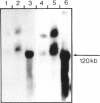Abstract
To identify the sequences involved in the expression of the fragile X and to characterize the molecular basis of the genetic lesion, we have constructed yeast artificial chromosomes (YACs) containing human DNA and have screened them with cloned DNA probes which map close to the fragile site at Xq27.3. We have isolated and partly characterized a YAC containing approximately 270 kb of human DNA from an X chromosome which expresses the fragile X. This sequence in a yeast artificial ring chromosome, XTY26, hybridizes to the two closest DNA markers, VK16 and Do33, which flank the fragile site. The human DNA sequence in XTY26 also spans the fragile site on chromosome in situ hybridization. When a restriction map of XTY26, derived by using infrequently cutting restriction enzymes, is compared with similar YAC maps derived from non-fragile-X patients, no large-scale differences are observed. This YAC, XTY26, may enable (a) the fragile site to be fully characterized at the molecular level and (b) the pathogenetic basis of the fragile-X syndrome to be determined.
Full text
PDF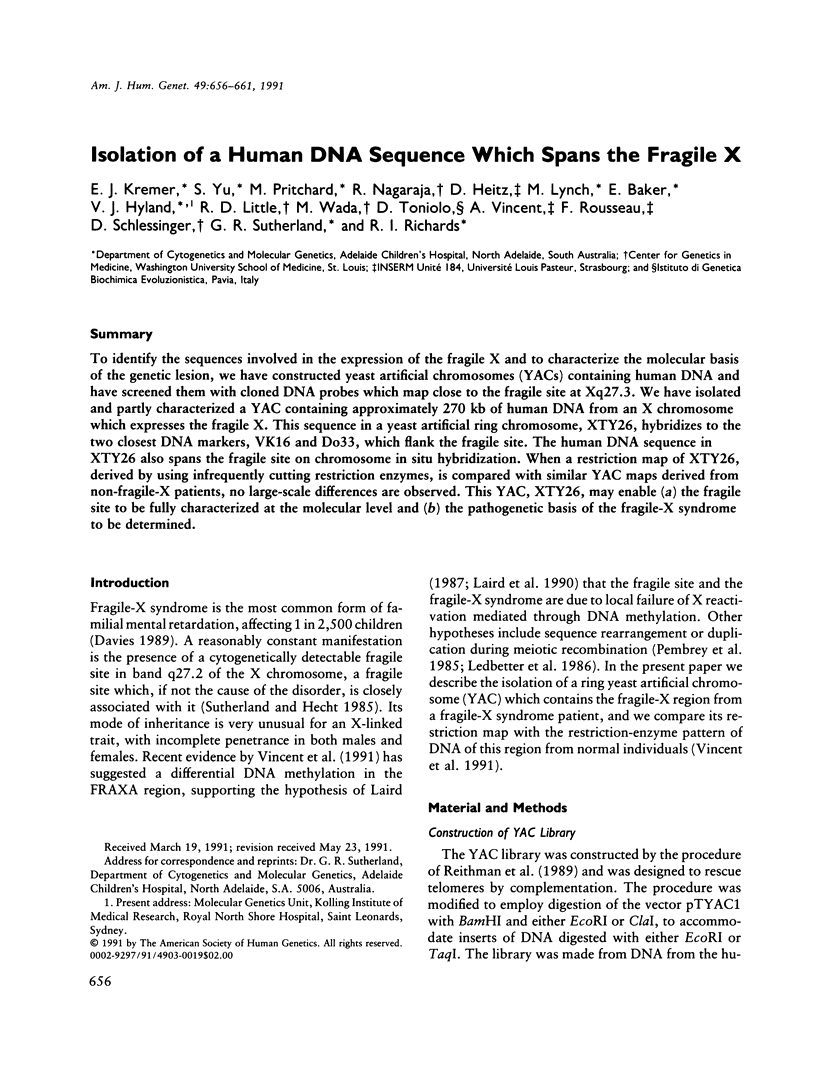
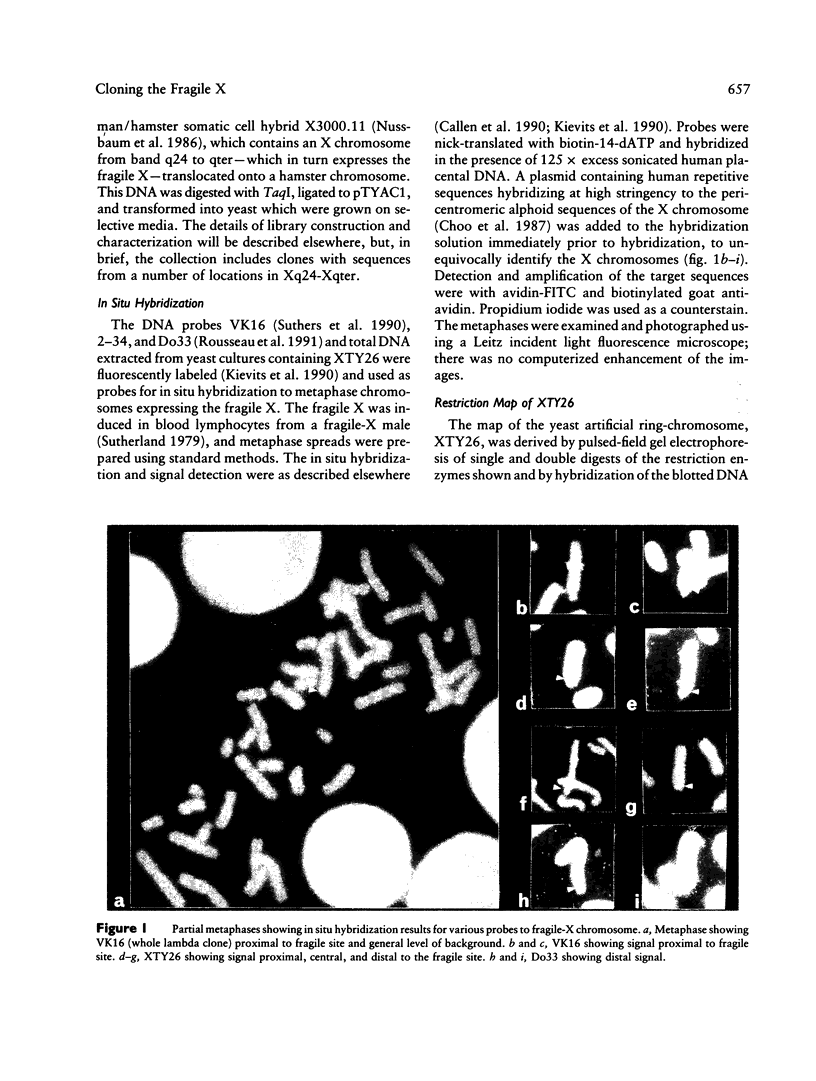
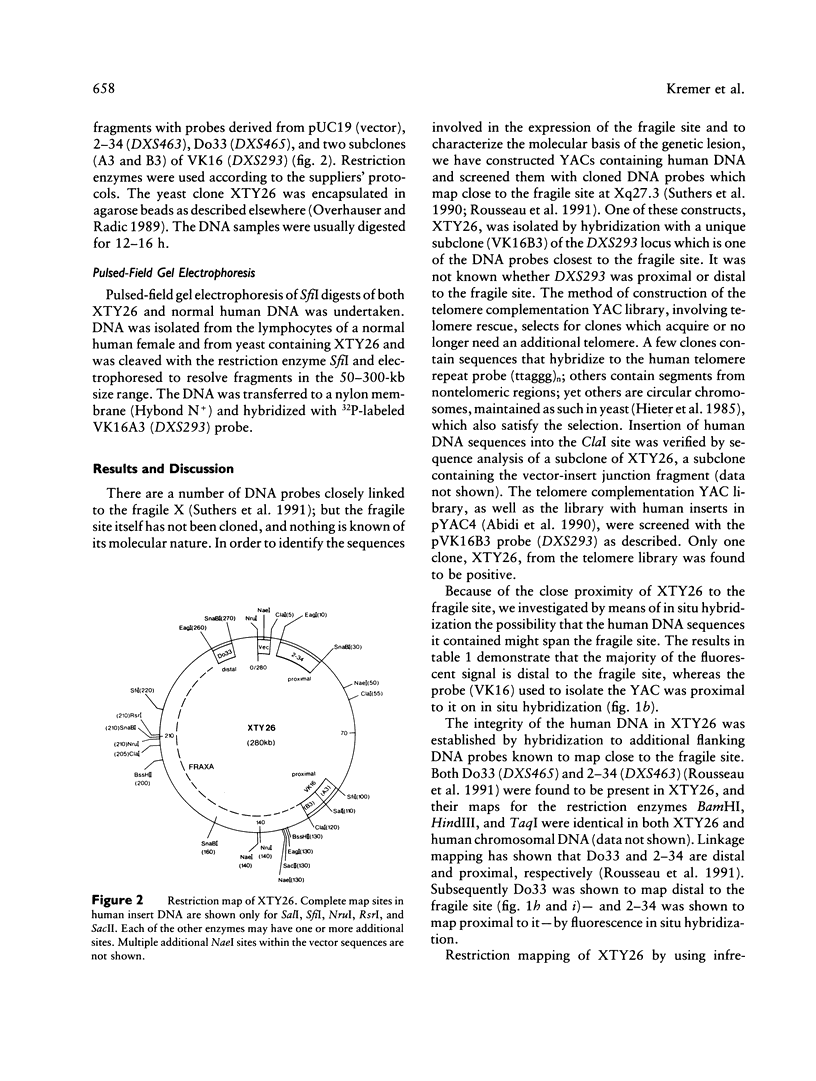
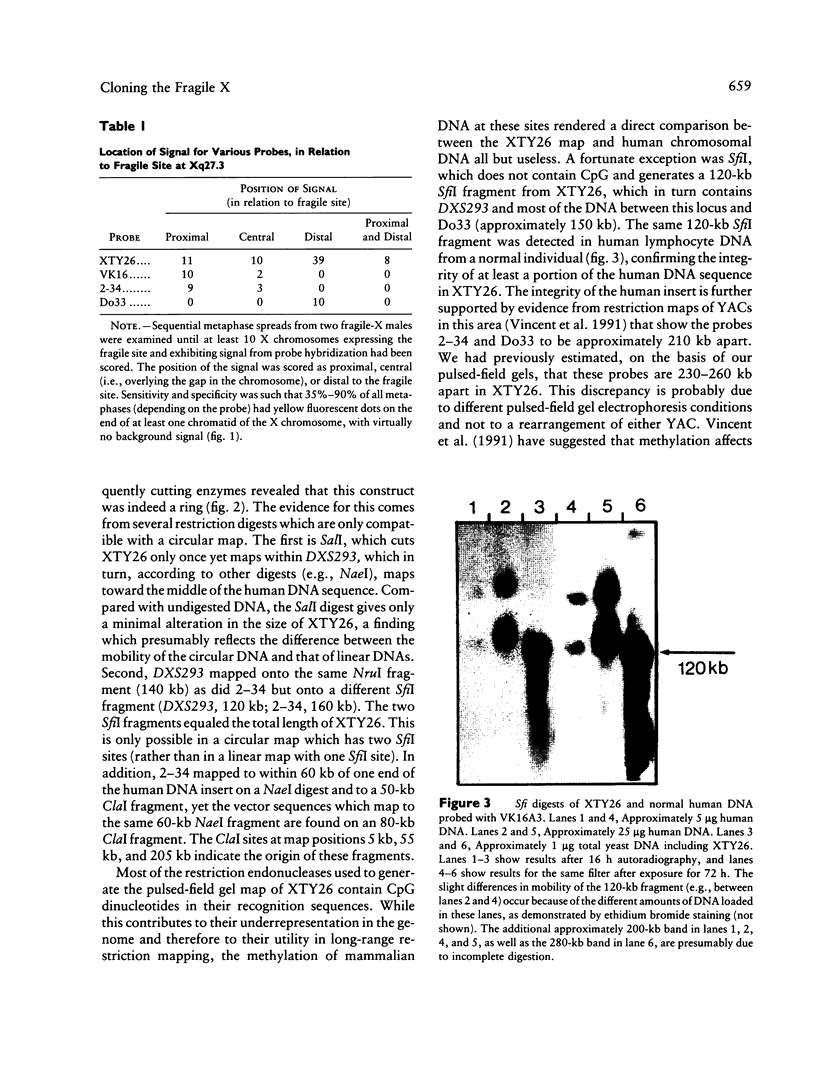
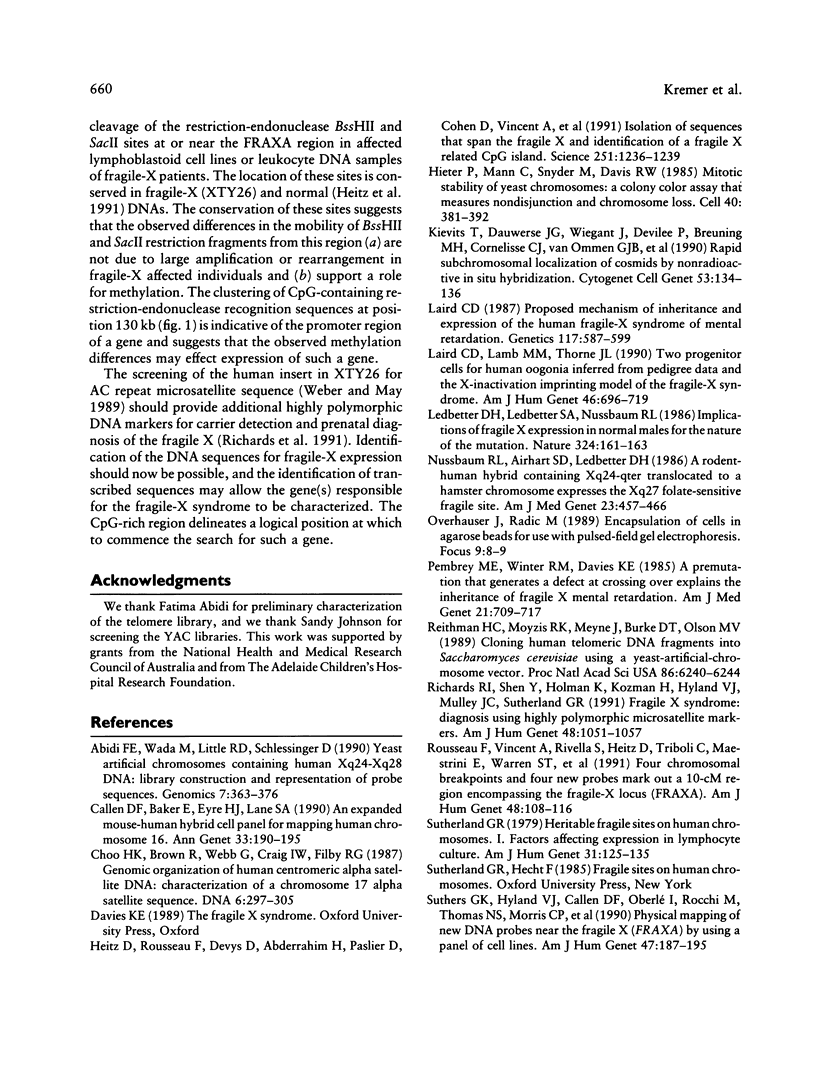

Images in this article
Selected References
These references are in PubMed. This may not be the complete list of references from this article.
- Abidi F. E., Wada M., Little R. D., Schlessinger D. Yeast artificial chromosomes containing human Xq24-Xq28 DNA: library construction and representation of probe sequences. Genomics. 1990 Jul;7(3):363–376. doi: 10.1016/0888-7543(90)90170-y. [DOI] [PubMed] [Google Scholar]
- Callen D. F., Baker E., Eyre H. J., Lane S. A. An expanded mouse-human hybrid cell panel for mapping human chromosome 16. Ann Genet. 1990;33(4):190–195. [PubMed] [Google Scholar]
- Choo K. H., Brown R., Webb G., Craig I. W., Filby R. G. Genomic organization of human centromeric alpha satellite DNA: characterization of a chromosome 17 alpha satellite sequence. DNA. 1987 Aug;6(4):297–305. doi: 10.1089/dna.1987.6.297. [DOI] [PubMed] [Google Scholar]
- Hieter P., Mann C., Snyder M., Davis R. W. Mitotic stability of yeast chromosomes: a colony color assay that measures nondisjunction and chromosome loss. Cell. 1985 Feb;40(2):381–392. doi: 10.1016/0092-8674(85)90152-7. [DOI] [PubMed] [Google Scholar]
- Kievits T., Dauwerse J. G., Wiegant J., Devilee P., Breuning M. H., Cornelisse C. J., van Ommen G. J., Pearson P. L. Rapid subchromosomal localization of cosmids by nonradioactive in situ hybridization. Cytogenet Cell Genet. 1990;53(2-3):134–136. doi: 10.1159/000132913. [DOI] [PubMed] [Google Scholar]
- Laird C. D., Lamb M. M., Thorne J. L. Two progenitor cells for human oogonia inferred from pedigree data and the X-inactivation imprinting model of the fragile-X syndrome. Am J Hum Genet. 1990 Apr;46(4):696–719. [PMC free article] [PubMed] [Google Scholar]
- Laird C. D. Proposed mechanism of inheritance and expression of the human fragile-X syndrome of mental retardation. Genetics. 1987 Nov;117(3):587–599. doi: 10.1093/genetics/117.3.587. [DOI] [PMC free article] [PubMed] [Google Scholar]
- Ledbetter D. H., Ledbetter S. A., Nussbaum R. L. Implications of fragile X expression in normal males for the nature of the mutation. Nature. 1986 Nov 13;324(6093):161–163. doi: 10.1038/324161a0. [DOI] [PubMed] [Google Scholar]
- Nussbaum R. L., Airhart S. D., Ledbetter D. H. A rodent-human hybrid containing Xq24-qter translocated to a hamster chromosome expresses the Xq27 folate-sensitive fragile site. Am J Med Genet. 1986 Jan-Feb;23(1-2):457–466. doi: 10.1002/ajmg.1320230137. [DOI] [PubMed] [Google Scholar]
- Pembrey M. E., Winter R. M., Davies K. E. A premutation that generates a defect at crossing over explains the inheritance of fragile X mental retardation. Am J Med Genet. 1985 Aug;21(4):709–717. doi: 10.1002/ajmg.1320210413. [DOI] [PubMed] [Google Scholar]
- Richards R. I., Shen Y., Holman K., Kozman H., Hyland V. J., Mulley J. C., Sutherland G. R. Fragile X syndrome: diagnosis using highly polymorphic microsatellite markers. Am J Hum Genet. 1991 Jun;48(6):1051–1057. [PMC free article] [PubMed] [Google Scholar]
- Riethman H. C., Moyzis R. K., Meyne J., Burke D. T., Olson M. V. Cloning human telomeric DNA fragments into Saccharomyces cerevisiae using a yeast-artificial-chromosome vector. Proc Natl Acad Sci U S A. 1989 Aug;86(16):6240–6244. doi: 10.1073/pnas.86.16.6240. [DOI] [PMC free article] [PubMed] [Google Scholar]
- Rousseau F., Vincent A., Rivella S., Heitz D., Triboli C., Maestrini E., Warren S. T., Suthers G. K., Goodfellow P., Mandel J. L. Four chromosomal breakpoints and four new probes mark out a 10-cM region encompassing the fragile-X locus (FRAXA). Am J Hum Genet. 1991 Jan;48(1):108–116. [PMC free article] [PubMed] [Google Scholar]
- Sutherland G. R. Heritable fragile sites on human chromosomes I. Factors affecting expression in lymphocyte culture. Am J Hum Genet. 1979 Mar;31(2):125–135. [PMC free article] [PubMed] [Google Scholar]
- Suthers G. K., Hyland V. J., Callen D. F., Oberle I., Rocchi M., Thomas N. S., Morris C. P., Schwartz C. E., Schmidt M., Ropers H. H. Physical mapping of new DNA probes near the fragile X mutation (FRAXA) by using a panel of cell lines. Am J Hum Genet. 1990 Aug;47(2):187–195. [PMC free article] [PubMed] [Google Scholar]
- Suthers G. K., Mulley J. C., Voelckel M. A., Dahl N., Väisänen M. L., Steinbach P., Glass I. A., Schwartz C. E., van Oost B. A., Thibodeau S. N. Genetic mapping of new DNA probes at Xq27 defines a strategy for DNA studies in the fragile X syndrome. Am J Hum Genet. 1991 Mar;48(3):460–467. [PMC free article] [PubMed] [Google Scholar]
- Vincent A., Heitz D., Petit C., Kretz C., Oberlé I., Mandel J. L. Abnormal pattern detected in fragile-X patients by pulsed-field gel electrophoresis. Nature. 1991 Feb 14;349(6310):624–626. doi: 10.1038/349624a0. [DOI] [PubMed] [Google Scholar]
- Weber J. L., May P. E. Abundant class of human DNA polymorphisms which can be typed using the polymerase chain reaction. Am J Hum Genet. 1989 Mar;44(3):388–396. [PMC free article] [PubMed] [Google Scholar]




